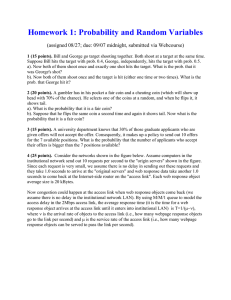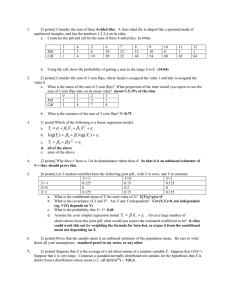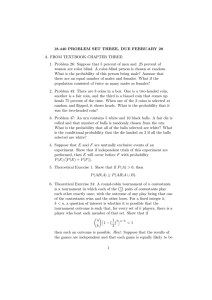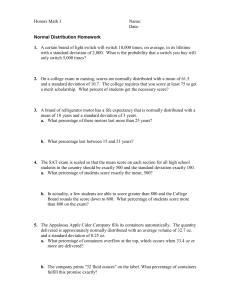Word
advertisement
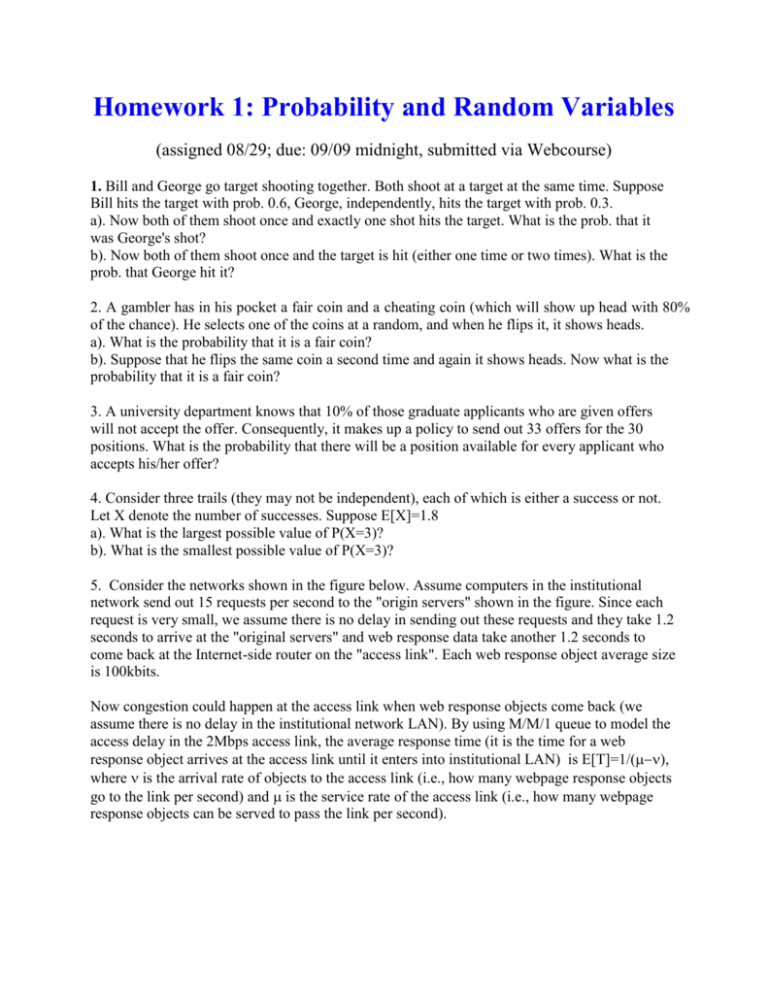
Homework 1: Probability and Random Variables (assigned 08/29; due: 09/09 midnight, submitted via Webcourse) 1. Bill and George go target shooting together. Both shoot at a target at the same time. Suppose Bill hits the target with prob. 0.6, George, independently, hits the target with prob. 0.3. a). Now both of them shoot once and exactly one shot hits the target. What is the prob. that it was George's shot? b). Now both of them shoot once and the target is hit (either one time or two times). What is the prob. that George hit it? 2. A gambler has in his pocket a fair coin and a cheating coin (which will show up head with 80% of the chance). He selects one of the coins at a random, and when he flips it, it shows heads. a). What is the probability that it is a fair coin? b). Suppose that he flips the same coin a second time and again it shows heads. Now what is the probability that it is a fair coin? 3. A university department knows that 10% of those graduate applicants who are given offers will not accept the offer. Consequently, it makes up a policy to send out 33 offers for the 30 positions. What is the probability that there will be a position available for every applicant who accepts his/her offer? 4. Consider three trails (they may not be independent), each of which is either a success or not. Let X denote the number of successes. Suppose E[X]=1.8 a). What is the largest possible value of P(X=3)? b). What is the smallest possible value of P(X=3)? 5. Consider the networks shown in the figure below. Assume computers in the institutional network send out 15 requests per second to the "origin servers" shown in the figure. Since each request is very small, we assume there is no delay in sending out these requests and they take 1.2 seconds to arrive at the "original servers" and web response data take another 1.2 seconds to come back at the Internet-side router on the "access link". Each web response object average size is 100kbits. Now congestion could happen at the access link when web response objects come back (we assume there is no delay in the institutional network LAN). By using M/M/1 queue to model the access delay in the 2Mbps access link, the average response time (it is the time for a web response object arrives at the access link until it enters into institutional LAN) is E[T]=1/(), where is the arrival rate of objects to the access link (i.e., how many webpage response objects go to the link per second) and is the service rate of the access link (i.e., how many webpage response objects can be served to pass the link per second). 2Mbps access link a). Find the total average response time when no institutional cache is used. The response time is the time from a browser sends out a request until it receives the web response object. (Hint: total delay includes Internet delay and access link delay, note that there is no delay at institutional LAN) b). Now suppose the institutional cache is used. The hit rate for the cache is 0.7. Find the total average response time. 6. The advantage of packet switching vs. circuit switching. The following figure shows that many users are sharing a 8Mbps access link to the Internet. Suppose each user is either in active status that required data access rate of 100k Bytes/second, or in silence status that the user requires no data. Each user is active 20% of the time, and users are independent with each other in their activities. 8Mbps access link a). If circuit switching is used, how many user can this access link support? b). If packet switching is used and there are 8 users. How often is this access link idle? How often does this link serve exactly two users? You must provide the final numerical solution. c). If packet switching is used and there are 20 users, how often does the access link be congested? You must provide the final numerical solution.
